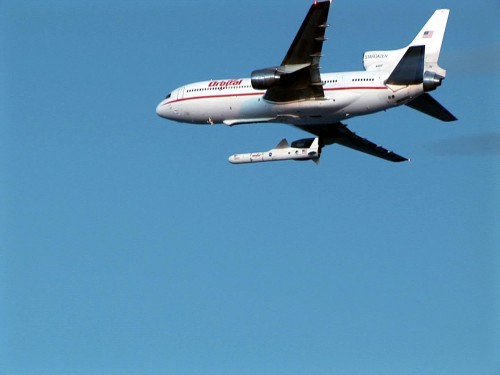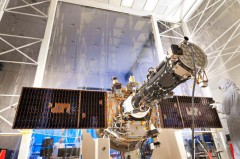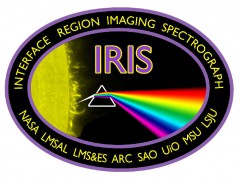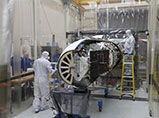
Orbital Sciences Corp. is ready to boost its 42nd Pegasus air-launched rocket aloft on the evening of Wednesday 26 June, ferrying NASA’s Interface Region Imaging Spectrograph (IRIS) payload into orbit. The 58-foot-long Pegasus-XL will fly out of Vandenberg Air Force Base, Calif., mounted beneath a Lockheed L-1011 “Stargazer” aircraft and will be released over the Pacific Ocean at an altitude of about 39,000 feet. After a brief period of free-fall, the rocket will sequentially burn its three solid-fueled stages to insert IRIS into its correct operational slot for an extensive program of solar study.
The launch of IRIS has been a long time coming. It forms part of NASA’s Small Explorer program, with mission costs capped at $105 million and a mandate to provide frequent, low-cost access to space for heliophysics and astrophysics using small-to-mid-sized satellites. Four years ago, it was selected by NASA from six Small Explorer candidates, and in June 2010 the space agency awarded Orbital a $40 million contract to launch it aboard Pegasus. Originally baselined to fly in December 2012, the IRIS launch has slipped several times, first into February, then April/May, and finally late June 2013.

Standing 7 feet tall, IRIS was built and integrated by Lockheed Martin Solar and Astrophysics Laboratory, upon whose shoulders the role of operating the mission will fall jointly with NASA’s Ames Research Center of Moffett Field, Calif. The satellite features a single scientific instrument—an 8-inch ultraviolet telescope, provided by the Smithsonian Astrophysical Observatory, coupled with a high-frame-rate, multi-channel imaging spectrograph—and seeks to observe how solar material moves, gathers energy, and heats up as it travels through a little-understood region of the Sun’s lower atmosphere.
In addition to providing solar physicists with greater awareness of the physical dynamics of our parent star, IRIS may help to explain what causes coronal mass ejections, which are primarily responsible for “space weather” and historically have demonstrated their ability to produce negative effects on terrestrial technologies and Earth-circling satellites. IRIS is the first mission to simultaneously observe conditions in the two regions closest to the Sun—the “chromosphere” and the “transition region”—which form a violently dynamic area in which hot and cold plasma are mixed over a range of altitudes.
“This location is where one of the most mysterious occurrences on the Sun takes place,” explained NASA on its IRIS webpage. “Usually, the closer you get to a heat source, such as a fire, the hotter it gets, but the solar atmosphere doesn’t do that. The solar atmosphere gets hotter as it gets further away from the Sun, and scientists don’t yet have enough information to distinguish between various theories on why this happens.” Indeed, the temperature changes from 6,000 degrees Kelvin at the solar surface to almost 1,000,000 degrees Kelvin at the top of the transition region.
“IRIS will contribute significantly to our understanding of the interface region between the Sun’s photosphere and corona,” said Joe Davila, IRIS mission scientist at NASA’s Goddard Space Flight Center in Greenbelt, Md. “This region is crucial for understanding how the corona gets so hot.” Although temperatures continue to climb in the outermost region, the “corona,” IRIS’ attention will be upon the chromosphere and transition region, since they contain more material and the strongest heating is believed to occur there. It seeks to gather data on how the chromosphere regulates mass and energy to the corona, what types of non-thermal energy dominate it, and how magnetic fluxes and matter “rise” through the Sun’s lower atmosphere.

“With the high-resolution images from IRIS, scientists will be able to use advanced computer models to unravel how matter, light, and energy move from the Sun’s 6,000 Kelvin surface to its million Kelvin corona,” said Eric Ianson, IRIS mission manager at NASA-Goddard. “Scientists will be able to combine data from NASA’s IRIS and Solar Dynamics Observatory and the NASA/JAXA Hinode missions to obtain a more comprehensive understanding of the Sun’s atmosphere.”
On 16 April 2013, IRIS arrived at Vandenberg, by which time the three stages of its Pegasus-XL launch vehicle had already been integrated. By the end of the month, the small satellite was electrically connected to the booster, preparatory to four extensive mission simulations during the next few weeks. On 30 May, IRIS was mounted atop Pegasus-XL and the two-piece payload fairing was installed shortly thereafter. Last Tuesday, a Flight Readiness Review concluded with a unanimous “Go” to proceed with the final steps toward a launch on 26 June. Those steps included mounting Pegasus-XL underneath the L-1011 fuselage Wednesday and a Combined Systems Test to verify the integrated performance of the booster, the aircraft, and the payload Thursday.
As a rocket, Pegasus’ air-launch capability makes it a unique asset, not least due to the fact that it can theoretically be deployed anywhere in the world. Since its maiden voyage on 5 April 1990, the winged booster has flown 41 missions and is designed to transport payloads weighing up to 980 pounds into low-Earth orbit. The “extended” Pegasus-XL—which benefits from lengthened first and second stages to enhance payload performance—first flew in June 1994. Both that mission and its second, in mid-1995, failed, but since March 1996 it has enjoyed an almost unblemished record. Its most recent flight, in June 2012, successfully delivered NASA’s Nuclear Spectroscopic Telescope Array (NuSTAR) into orbit.
Over the years, Pegasus missions have been despatched from runways at Cape Canaveral Air Force Station, Fla., Dryden Flight Research Center at Edwards Air Force Base, Calif., Wallops Flight Facility in Wallops, Va., and Kwajalein Atoll in the Marshall Islands of the Pacific Ocean. And therein lies another key advantage. Since the L-1011 carrier aircraft transports the booster to an altitude of around 39,000 feet prior to deployment, crosswinds acting upon Pegasus are much gentler than they might be for a ground-launched rocket. Although meteorological conditions can still interfere with the initial takeoff and delivery to the deployment location, Pegasus is described as largely immune to weather-related delays when it reaches altitude.

Wednesday’s mission is currently scheduled to occur within a five-minute “window,” which opens at 7:27 p.m. PDT (10:27 p.m. EDT). After taking off from Vandenberg, the L-1011—originally purchased from Air Canada by Orbital Sciences in 1994—will deliver Pegasus-XL to its desired altitude. After release, the booster will enter a five-second period of free-fall, ahead of the ignition of its Orion 50S first-stage engine. This will burn for 77 seconds and achieve a peak altitude of more than 200,000 feet. Pegasus-XL’s 45-degree delta wing will provide additional lift and its tail fins will enable steering. By the time the Orion 50S burns out and separates, the booster will have already gone hypersonic.
The turn will then come for the Orion 50 of the second stage, which will fire for 78 seconds, providing pitch and yaw controllability, whilst nitrogen thrusters on the third stage will handle movements about the roll axis. Midway through the second-stage burn, Pegasus-XL’s two-piece payload fairing will separate and expose IRIS to the vacuum of space. Finally, after the second stage has been jettisoned, the Orion 38 third-stage motor will ignite for 64 seconds to deliver the payload into orbit. “With the aerodynamic lift generated by its unique, delta-shaped wing,” noted Orbital on its website, “Pegasus typically delivers satellites into orbit in a little over 10 minutes.”
Want to keep up-to-date with all things space? Be sure to “Like” AmericaSpace on Facebook and follow us on Twitter:@AmericaSpace
Missions » IRIS »



But WHICH orbit? I understood Canaveral was forbidden to launch because of overflying densely-populated areas, which makes sense going east, and west is only exceptionally even sane, but both polars are OK. So, north or south?
An extra advantage of air-launching is that you can cancel out some of the earth’s rotation, when this is necessary for a polar orbit, by dropping with the aircraft heading west; another is that it can be pitched nose-up quite a number of degrees.